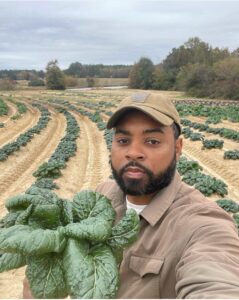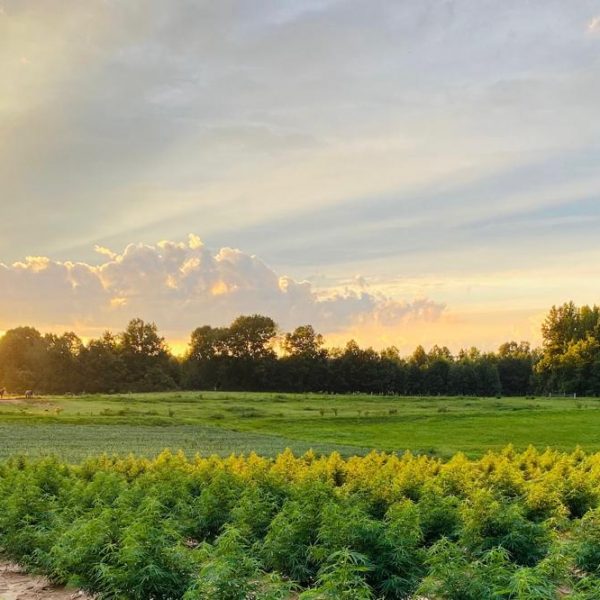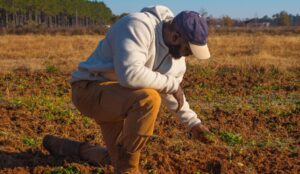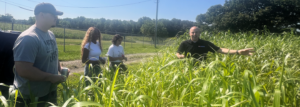According to the 2022 USDA Census, the average age of U.S. farmers is now 58.1 years. Nearly two-thirds are over 55. That reality alone poses a serious question: Who will feed us in the future?
Attracting younger generations into farming is no small feat. High land prices, the steep capital required for equipment and operations, and the consolidation of agricultural enterprises have made it nearly impossible for young people, especially those without generational wealth, to get started. Add to that the perception that rural life lacks the amenities of urban or suburban living, and it’s easy to see why few see farming as a viable path forward.
As a young Black farmer (4th generation on our family’s land) currently training my nephews (the 5th generation), I ask: What can we do—practically and urgently—to bring more people like me and my nephews into this work?

1. It’s a Lifestyle, Not a Job
Farming ain’t gonna make you rich—not in money, anyway. But if you’re looking for peace of mind, purpose, and a life where you work for yourself and stay connected to the earth, there ain’t much better. It’s not about luxury—it’s about doing something real, something that feeds your soul while you feed your people.
2. Exposure is Everything
You can’t aspire to something you’ve never seen. A lot of young folks don’t even think about farming ‘cause they’ve never really seen it up close. Heck some kids even think that food comes directly from the grocery store. Let alone have visited a local farm. When I was growing up I had to get my hands dirty, born into waking up at 6am in the morning helping my late father with farm chores. Spending time working side-by-side with his farm hands. It was a way of life, a life I would never trade for the world and so thankful to have been raised like that.
Programs like Nature For Justice are doing just that by bringing young people to real farms to learn hands-on, create future farmers of America and build community. CEO Hank Cauley co-founded this amazing organization to support current farmers and grow future farmers and I delighted to work as the Director to facilitate these efforts.
3. Land Access is the Gatekeeper
Without land, farming is just a dream. Young farmers need help identifying land with a clear title and accessing it affordably. We need policies that favor land development with an eye to the long term, not speculation. Let’s be real plain and simple without land, you ain’t farming. That’s the biggest barrier for a lot of aspiring farmers.
We need more support to find land that’s actually available and affordable land with a clean title, too. That means land banks, land trusts, and co-op ownership options. And we need laws that protect land for growing food, not just flipping it for profit.
4. Tools, Tech, and Training
Farming today ain’t just tractors and dirt, it’s drones, apps, and data. The new generation already knows tech, and we should be using that to our advantage. But folks need more than just gadgets, they need the training to use it right, and the money to get started. Farming now depends as much on digital fluency as it does on mechanical know-how.
We need funding for on farm internet, farm management software, and hands-on tech training. It’s a different kind of toolbox now.
5. Financing the Future
Money makes the mission move. No matter how smart or tech-savvy a new farmer is, without capital, they’re stuck. Farming comes with massive upfront and ongoing costs, and weather and market volatility only raise the financial stakes.
Young farmers need patient capital, such as low-interest loans, grants, and flexible funding that supports them through tough years, not just good ones. We also need more financial literacy training and advisory support to help farmers navigate the complex funding landscape. We need low-interest loans, flexible funding, and grants that stick with us through the rough seasons, not just the good ones. Plus, financial training so we know how to make smart moves with what we’ve got.
6. Wisdom of the Elders
Elders hold the blueprint. No app can teach you what an elder knows from working the land for decades. That wisdom matters about growing, yes, but also about staying strong, keeping legacy alive, and honoring the land.

Programs like the ones run by Nature For Justice connect younger farmers with seasoned ones, so we can pass down more than just skills – we pass down culture, too. That’s what keeps this thing alive.
We ain’t trying to go backward, we’re building forward. One where young farmers have land, tools, knowledge, and support. N4J’s Growing American Farmer Prosperity Program is part of that vision. Let’s build this bridge together. We’ve fed this country for hundreds of years, let’s keep on doing it through small farms. Let me hear from you.







